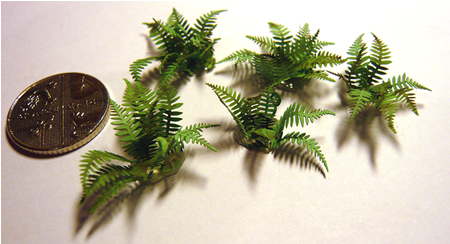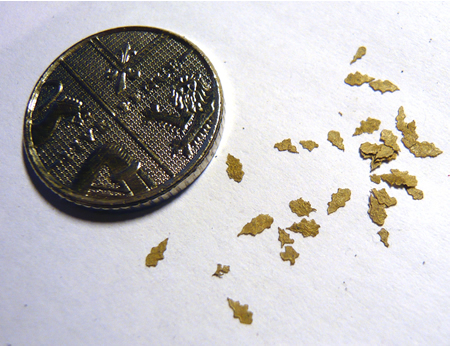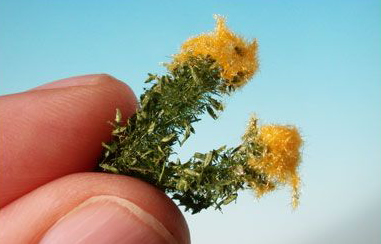|
modelling plants and flowers

Glenthorne Hotel gardens
Perhaps the most time consuming part of
making scenery are the smaller plants and flowers. The pioneering work of
Roy England on Pendon has placed new demands of the modeller if anything
reasonably acceptable is to be achieved. On the other hand, very few
people are prepared to spend 2000 hours making just one cottage!
Gradually, we are developing our own techniques which can be achieved in a
relatively short space of time.
I shall describe the methods used so far.
There are still a lot of other plants to add once we have the technology
in place.

railway boundary fence
We select tiny branches of sea moss, spray
with adhesive and add some fine turf scatter. A small hole is made in the
Polyfilla with a dental pick and the plant glued in with PVA. When dry,
the white blooms are painted on.

foxgloves in the shade of a hedge
We use bristles from a wall paper brush.
These are coated in PVA then dipped in green scatter followed by a light
coating of 'heather' scatter. Excess is removed, and when dry, the plants
are individually planted through course turf scatter.

border around bowling green
These flowers were very popular in the 1930s.
We again used wall paper brush bristles, dipped in PVA then plunged into
very fine ballast. The result is an excellent shape, the bristles, being
tapered themselves. The blooms are then painted on, with the tips being
painted light green, to represent buds. There are 230 blooms planted
around the bowling green. The same technique can be used for red hot
pokers.

rose garden
Standard roses are made from carefully
selected small branches of sea moss. These are spray glued and green
scatter attached. The blooms are added individually and are one of the
slightly larger white scatter products. These are painted the required
colour when dry. One must remember that the choice of rose colours pre-war
was quite restricted. Climbing roses are made from a fuse wire armature,
spray painted then green scatter of the correct colour attached. For
rounded blooms, we use very small poppy seed painted in the base colour.
These are attached and further detailing added then, such as white centres
as seen in the photo below of an American Pillar rose. More open blooms
are represented by larger scatter material which is individually painted
to the required colour after attachment.

American Pillar rose on mews
For the most part, we use various types of
scatter and 'clumping' material and paint on the blooms. We find that
painting all blooms gives a more vivid effect which we prefer. A more
detailed method is used at the front of the layout, where individual stems
are made using painted fuse wire and the flower head attached with PVA.
Small punches are used to cut out pre-coloured paper to make flower heads
such as those for dog roses.
These days it seems 'de rigueur' to include a
vegetable patch. Cabbages are made from modellers clay and the leaves carved with a
dental pick. They are painted and attached to open leaves made from cut
tissue paper. Other plants are made using scatter material and clumping.
The runner beans are made in a similar manner to the brambles, described
below.

The signalman's allotment......cabbages, runner beans, potatoes and a
marrow plant.
We make brambles with fuse wire armatures,
spray painted and then covered in scatter of the appropriate colour. The
shoots can be formed over the landscape once planted.

brambles in Glenthorne cutting
The conventional way to make these is
naturally. The material is Asparagus fern (Asparagus densiflorus 'Sprengeri'), bought from a florist shop. First, separate the
fronds from the main stem and spray the desired colour. The natural colour
will quickly fade.
Then immerse the fronds
completely in a glycerine/water mix (1 : 3) overnight. This will preserve
the fronds and prevent them becoming brittle.
Cut the fronds into small
pieces and you have perfect bracken and ferns.
For a king's ransom, one can buy ferns in
brass etchings. I personally do not like them as they really do look like
they are metal, no matter what one does.
After
a lot of experimentation, we have found it possible to have scale leaves
accurately cut using a paper cutting laser. So far we have small samples of
Virginia Creeper leaves and bracken. The solution is much cheaper than
etched brass and the result appears more organic.

Part of the laser cutting pattern for bracken. Each frond is 6mm long

bracken



oak leaves: these can be green or autumn (and don't cough!)
|
miniature commercially available plants |
I have tried a new product available from
International Models. The flowers, which come in a variety of colours do
make very nice roses, or if bunched up, a credible flowering bush.


I have also tried the Mininatur ivy. I find
the leaves a bit out of scale and that the medium is far too stiff to
easily form. I wish that I could get the same result as the publicity shot
below!

Busch have now brought out a range of tiny
plastic plants. The cost is beyond belief and in my view, not all of them
look right. For sure, they need properly painting. These products can be
seen in the bigger exhibitions these days so you can be your own judge!
Some of their products are shown below.









|